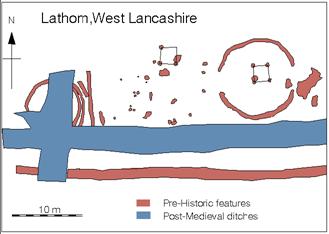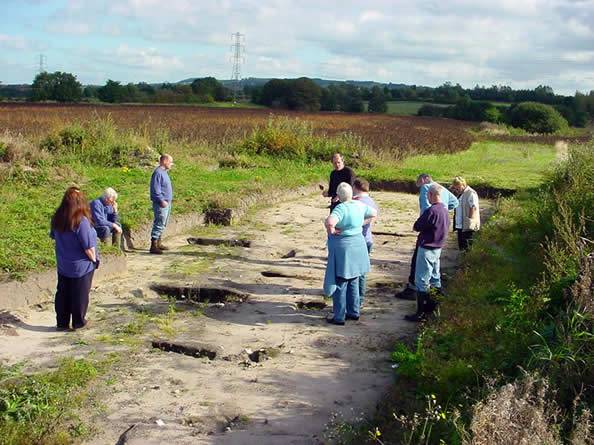Romano-British Lancs - Insight
|
|
 We were lucky to catch the last of the good weather for last
month’s field trip to Dutton’s Farm. It turned out to be a most enjoyable
morning thanks to our guide Ron Cowell from Liverpool Museum. We were lucky to catch the last of the good weather for last
month’s field trip to Dutton’s Farm. It turned out to be a most enjoyable
morning thanks to our guide Ron Cowell from Liverpool Museum.
As I mentioned in last month’s Newsletter, Ron and his team have been excavating here
over the last few years and have uncovered a wealth of information about everyday life in
Pre-historic Lancashire.
Iron Age Farmstead
The main settlement consists of five or six roundhouses, many pits and two granary
buildings, dating to about 150 BC to 150 AD. It was possibly set within a large encircling
ditch, which would have had a bank and hedge on its inner edge. This may have replaced a
wooden palisade or large fence.
About 60 m to the south of the main settlement a series of further settlement features
have also been found. These are, as yet undated, but superficially they appear similar to
those already uncovered for the late prehistoric and Romano-British periods in the main
settlement area. 
Roman Period
The main settlement may have been abandoned in the early Roman period as a Roman
trackway runs across its western edge. This suggests that between about the 2nd to 4th
centuries AD, the farming landscape of the settlement changed dramatically. Other elements
of this early agricultural landscape have been found about 80 m to the west, where there
is a network of other trackways and field boundaries of Roman and later date, some of
which may be pre-Norman.
Dutton's Farm is situated on the right-hand side of the main road to Burscough, opposite
the Lathom Hall Park Estate. Ron and his team will be here again next season, excavating
the site as part of a structured training programme. Organised by the University of
Liverpool, these courses allow students and professionals to work along side each other.
If you are interested please contact Mrs Leslie Crombie, Centre for Continuing Education,
University of Liverpool, 19 Abercromby Square, Liverpool, L69 7ZG
Tel: 0151 794 2550/6900
Next Meeting
Wednesday 6th November at the BP Centre (Scout HQ) in Greenough Street, at 7.30 pm as
usual. This month’s speaker is Bernard Champness from the North-West
Regional Industrial Archaeological Society, whose talk will be on ‘Industrial
Archaeology of East Lancashire’, which I am told will have a specific link
with Wigan. Bernard and his colleagues have shown great interest in our Arley mill sites
and the industrial landscape of the Arley valley. They think there is great potential for
a joint study and research project, which could probably include funding from the National
Heritage Initiative. We will be able to discuss this with Bernard after the meeting. Hope
to see you there.
Time Flyers
is a news series on BBC2 on Thursdays at 7.30pm. Watch out for the episode on the Roman
frontier in Scotland. In it, a team from Manchester University excavate along the line of
the Gask frontier, a series of Roman forts and watch towers stretching from Perth to
Dunblane which marked the line reached by Agricola. We are told by the historian Tacitus
that, the then governor of Britain, marched his legions as far north as the Moray Firth
and fought a decisive battle there in 84AD, before being immediately recalled to Rome.
This new research, however, shows that the Romans were in Scotland for as long as 15
years, before their eventual withdrawal in late 86AD. The Manchester team have found
strong oak forts rebuilt, in some cases not once but twice, suggesting the Romans stayed
much longer than 18 months. The evidence of rebuilding and coins found on the sites have
led to a date for the first Roman conquest at around 70AD, a decade earlier than was
previously thought. This means it would not have been Agricola, who happened to be
Tacitus's father-in-law, doing the conquering, but one of his predecessors, Petilius
Cerealis or Sextus Julius Frontinus. This has huge implications for Roman occupation in
whole of Northern Britain.
|



